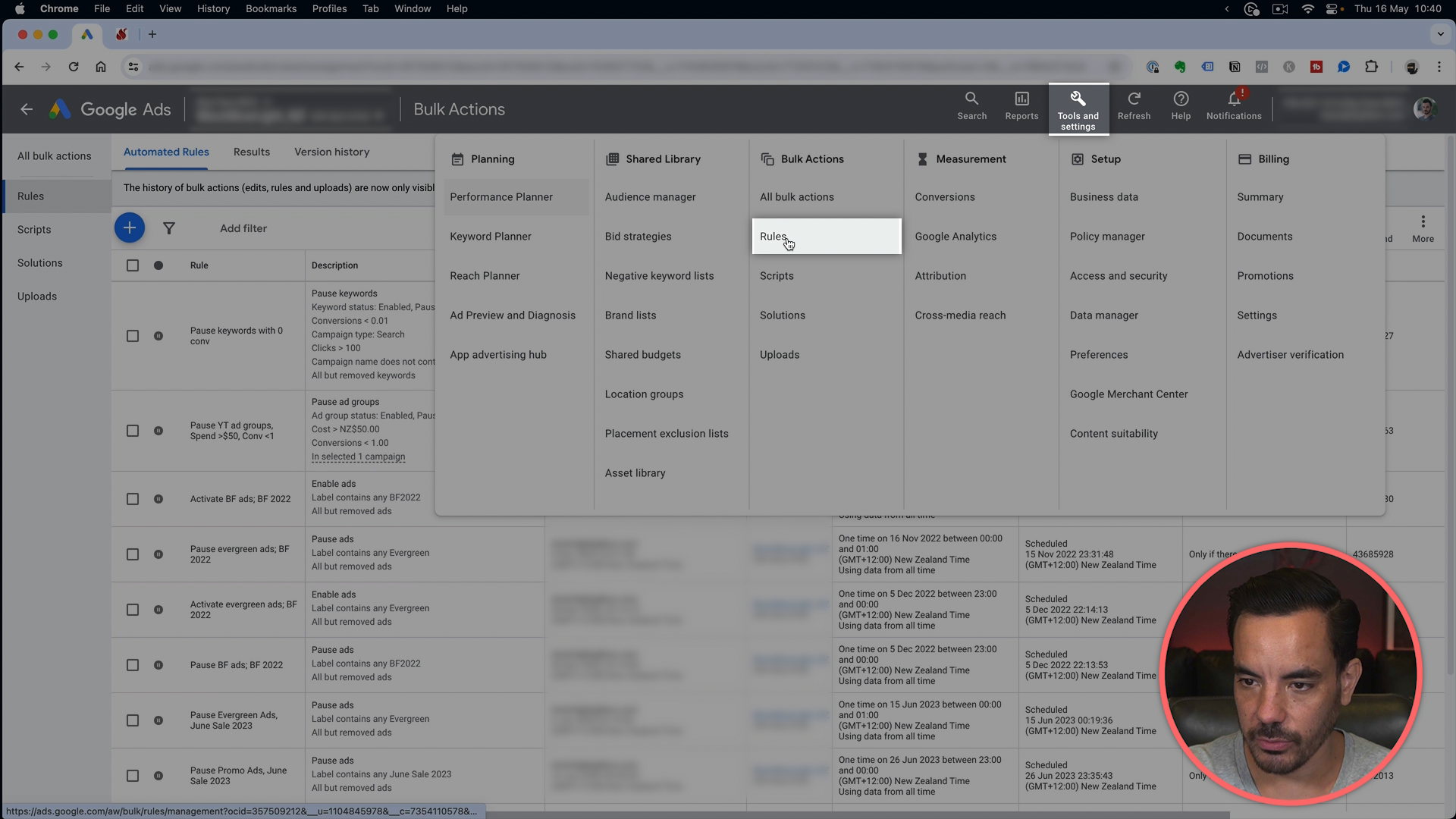Today, we’re diving into the powerful world of automated rules in Google Ads. I'll guide you through setting them up and share 8 must-have automated rules to supercharge your account performance.
If you prefer to watch this blog post as a video, click here.
Automated rules in Google Ads are a game-changer for busy ecommerce store owners. By the end of this newsletter, you’ll know how to implement these rules to achieve better results while saving time.
Where to Find Automated Rules
First, let’s locate the automated rules. Head to Tools and Settings, then under Bulk Actions, click on Rules.
If you’re using the new interface, find Bulk Actions on the left sidebar. Click the plus sign to create a new rule.
You’ll see options for naming the rule, selecting the account, setting actions, filters, conditions, and frequency, and enabling email notifications for changes or errors.
Always preview your rule before saving it, to ensure it functions correctly.
Here are my top 8 recommended rules to run:
1. Stop Google Overspending Your Budget
Google Ads can overspend your daily budget by up to 200%, which can disrupt your finances. This rule enforces a strict daily budget.
Create a campaign rule named “Pause Overspend Campaigns.” Select the appropriate campaigns and set the condition for cost to pause campaigns if the cost exceeds your specified limit (e.g., $500). Set the frequency to hourly and use data from today.
Next, create a second rule named “Re-enable Paused Campaigns.” Use the same campaign and cost conditions but change the action to enable and use data from yesterday. Set this rule to run daily early in the morning.
2. Turn Ads On/Off for Your Sale
Automate the activation and deactivation of promotional ads for sales or events.
Create an ad rule named “Enable Sale Ads.” Add a condition for ad text that contains your sale-specific text (e.g., “25% off”). Set the frequency to once on the start date of your sale. Set the action to enable the ads.
Create a second rule named “Pause Sale Ads” with the same conditions, set to run once on the end date of your sale. Action should be set to pause the ads.
3. Pause High Spend, No Conversion Keywords
Stop wasting money on keywords that don’t convert.
Create a keyword rule named “Pause No Conversion Keywords.” Set the conditions to pause keywords if the cost exceeds your threshold (e.g., $300) and conversions are less than 0.1.
Run this rule daily.
4. Pause Low Performing Keywords
Pause keywords that are underperforming to allocate budget more effectively.
Create a keyword rule named “Pause Low Performing Keywords.” Set the conditions for cost (e.g., £600) and conversion value per cost less than 1. Set the action to pause keywords that meet this condition.
Run this rule daily.
5. Monthly Budget for a Group of Campaigns
Ensure a group of campaigns stays within a monthly budget.
Create a campaign rule named “Monthly Budget for Campaigns.” Select the campaigns and set the condition for cost exceeding your monthly limit (e.g., $10,000). Tell it to pause the campaigns if they exceed this limit.
Run this rule hourly using data from this month.
6. Lower Budget for Weekends
Adjust budgets for periods with lower sales activity, like weekends.
Create a campaign rule named “Lower Budget on Weekend.” Select the campaigns and set the action to decrease the budget by a percentage (e.g., 50%). Run this rule weekly on Saturday morning.
Create an opposite rule to increase the budget back to normal on Monday morning.
7. Increase Budget for High Performing Campaigns
Boost budgets for campaigns that are performing exceptionally well.
Create a campaign rule named “Increase Budgets for High Performing Campaigns.” Set the condition for return on ad spend greater than your target (e.g., 6). Increase the budget by a small percentage (e.g., 10%) daily using data from the past 30 days.
8. Lower Budget for Low Performing Campaigns
Reduce budgets for campaigns that are not performing to standard.
Create a campaign rule named “Decrease Budgets for Low Performing Campaigns.” Set the condition for return on ad spend less than your target (e.g., 2). Decrease the budget by a percentage (e.g., 10%) and run it at your desired frequency.
Automated rules in Google Ads can significantly streamline your campaign management, ensuring your budget is optimally spent and your ads perform better. Implement these eight rules to take your ecommerce store's Google Ads performance to the next level.





